Research Area A – Water, carbon and volatile organic compound (VOC) fluxes along the different ecosystem compartments and across scales
Area A will assess key plant, soil and ecosystem processes such as photosynthesis, respiration, ecohydrological H2O fluxes, and soil-plant-atmosphere interactions. We will measure pools and fluxes of H2O, CO2 and volatile organic compounds (VOC) in mixed and pure beech and spruce stands. Installation of a novel tailored sensor network covering different scales, from soil, trees, canopy up to the atmosphere will assess the significance of spatio-temporal heterogeneity in ecosystem fluxes and stress impacts.
A1 Multifunctional and energy-autonomous soil probe systems for measuring carbon fluxes in the tree root environment
A1.1 Tracing soil ecological processes of CO2-fluxes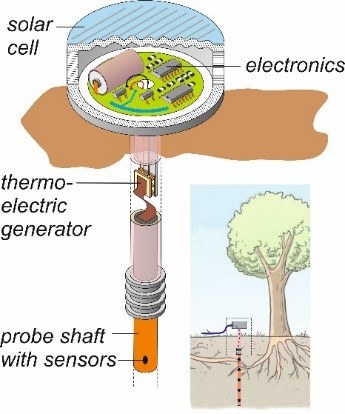
We will assess the spatio-temporal heterogeneity in soil fluxes and microclimatic/edaphic conditions to evaluate the importance of rhizosphere and microbial sources, and identify hot spots and hot moments in microbial and tree root respiration and their interactions.
Open positions: currently there are no open positions in this subproject.
PIs: Prof. Dr. Friederike Lang and PD Dr. Helmer Schack-Kirchner
A1.2 Multifunctional and energy-autonomous soil probe systems
We will develop novel soil probes measuring CO2 and temperature, which can be installed with high spatial coverage in a measuring grid. They will be energy-autonomous through thermo-electric and solar energy harvesting and thus perfectly fulfil a “deploy-and forget” strategy.
Open positions: currently there are no open positions in this subproject.
PIs: Prof. Dr. Peter Woias and Prof. Dr. Jürgen Wöllenstein
A2 Linking carbon and water fluxes in trees to the soil and atmosphere using in-situ NMR and ecohydrological sensor cluster
A2.1 Ecohydrological fluxes and processes within a mixed forest ecosystem 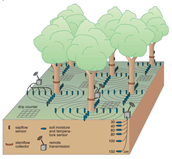
We will address ecohydrological fluxes and processes in heterogeneous forest patches investigating dynamics and spatial patterns in root water uptake, tree sap flow and phloem carbon isotopes, its feedbacks on spatio-temporal soil moisture variability and heterogeneity, and how this, in turn, affects tree water use efficiency and phloem sugar transport. We aim to trace water and carbon fluxes in trees and sharpen our picture of biotic controls.
Open positions: currently there are no open positions in this subproject.
PIs: Prof. Dr. Markus Weiler and Prof. Dr. Christiane Werner
A2.2 In situ flow-MRI and NMR to measure water and phloem sap flow 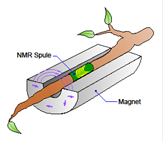
We will develop a fully novel methodology through compact Magnetic Resonance Imaging (MRI) / Nuclear Magnetic Resonance (NMR) sensors based on permanent magnets attached to small‑sized branches. They will allow for in situ imaging of the H2O fluxes without interfering with the branch, and NMR analysis of xylem and phloem sap flows. Continuous in situ phloem sap NMR measurements will allow a new dimension of quantifying integrated carbon transport in trees.
Open positions: currently there are no open positions in this subproject.
PIs: Prof. Dr. Jan Korvink and Dr. Mazin Jouda (KIT)
A3 An autonomous, multi-cuvettes laser-spectrometer system to study leaf photosynthetic isotope discrimination, CO2 exchange and volatile organic compound (VOC) emissions
A3.1 Spatial and temporal resolution of leaf 13CO2 and VOC fluxes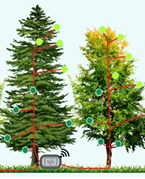
We will capture spatial and temporal dynamics in leaf gas exchange within and among tree crowns in a mixed forest. Environmental impact can be identified by 13C-isotope discrimination during photosynthesis, reflecting changes water use efficiency. Volatile organic compound (VOC) emissions are further sensitive tracers of abiotic and biotic stress, which can reveal hot spots and hot moments of these key fluxes.
Open positions: currently there are no open positions in this subproject.
PIs: Prof. Dr. Christiane Werner and Dr. Simon Haberstroh
A3.2 Development of miniaturized leaf cuvettes and compact laser spectrometer for 13CO2 isotopes
Micro gas cuvettes will be developed and deployed in large numbers to monitor the 3D-variability of 13CO2 isotope discrimination within the canopy. Equipped with an integrated open-close mechanism, they will be connected to multiple small, low-cost carbon isotope laser spectrometers, which will also measure leaf H2O fluxes. As the laser spectrometers cannot be miniaturized to a similar extent as the leaf cuvettes, they will be placed at a central position and connected by tubing.
Open positions: currently there are no open positions in this subproject.
PIs: Prof. Dr. Ulrike Wallrabe and Dr. Katrin Schmitt
A4 Process-based ecosystem-atmosphere exchange of CO2, H2O and volatile organic compounds (VOCs)
A4.1 Ecosystem-level responses and feedbacks in ecosystem-atmosphere exchange of CO2, H2O and VOCs in a heterogeneous forest ecosystem 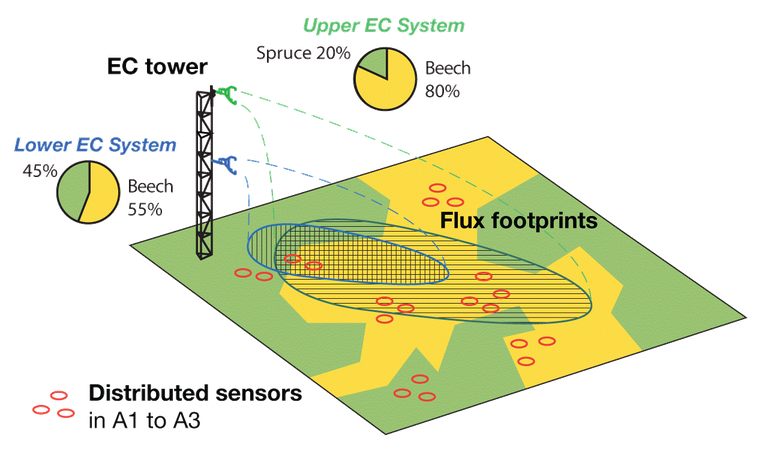
To bridge the gap between the relatively small scale of an individual tree, and a forest stand, A4.1 will assess ecosystem-atmosphere exchange by three towers for eddy covariance measurements of H2O, CO2 and its isoflux (13CO2), to separate fluxes into components (ecosystem respiration and gross primary production) at an integrated scale. Further VOC uptake and release by our forests will be measured, linking to important ecosystem functions, which are strongly sensitive to environmental changes.
Open positions: currently there are no open positions in this subproject.
PIs: Prof. Dr. Andreas Christen and PD Dr. Jürgen Kreuzwieser
A4.2 Development of a interband cascade laser-based measurement system for studying ecosystem-atmosphere exchange of VOCs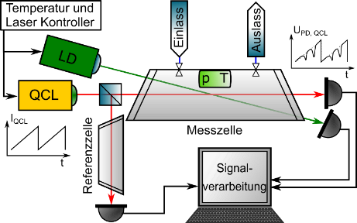
Here, we will develop, for the first time, an optical spectroscopic sensing technology, to measure VOCs using tuneable laser absorption spectroscopy (TLAS), i.e., concentration gradients along the tower (A4.1) and connected to single-leaf cuvettes, as developed in A3.2.
Open positions: currently there are no open positions in this subproject.

